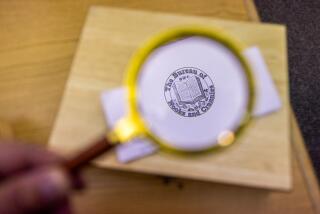Language translates to movement in ‘Bones’
- Share via
Made for the Los Angeles Public Library’s Central Library, Loretta Livingston’s new dance, “Read the Bones,” is a quiet, thoughtful piece inspired by Jud Fine’s fountain work outside the library’s Flower Street entrance.
So many people enter the downtown library from the parking lot, traveling by internal staircase or elevator practically right to the library’s doorstep, that they miss the fountains and the Maguire Gardens.
This is a huge mistake of public planning. Fine’s pools and wells for the library’s formal entry are designed to wash people’s minds clean, to prepare them to receive text and, specifically, to get them think about biological evolution.
It is one of the more beautiful settings in downtown Los Angeles, leading to one of the most important and magnificent buildings. We should be made to see it -- which is precisely what Livingston’s “Read the Bones” did over the weekend, when performed in the Mark Taper Auditorium.
“Read the Bones” is about reading the human body. Livingston and her astute collaborators in music, video and lighting ask: Can one decode the biological messages that transform the meanings of gestures?
Her five dancers -- all of whom contributed during the making of the work -- responded by building a discrete, coherent and legible language. No small accomplishment, “Read the Bones” doesn’t look like anything else. It is in and of its own world, using a system that excludes lifts and all but two leaps. Almost every gesture manifested itself as a physical hieroglyph that was subsequently passed around by the dancers like a game of telephone.
The trouble was not that it was hard to figure out but that there was too much information, taking too much time for one sitting. “Read the Bones” needed an editor to stick it to the bones and cut it short.
That said, the whole first section worked. Moonea Choi’s dancing throughout epitomized the words on Fine’s three pools outdoors: bright, lucid and clear. She was a total revelation. So too was Kate Johnson and Michael Masucci’s video -- particularly the segue into the second section during which a woman submerged, face up in a pool, morphed into the naked, dry back of another person.
Robin Cox’s score for hand percussion and marimba, played live by Erik Leckrone and Eric Mellencamp, had one thinking, “If cells could make music, would these be the sounds?” And Russell Pyle’s down-lighting on the biology lab-like jars filled with water and textual scrolls focused on the tension between science and art -- aided by the omnipresence of Livingston’s other fine dancers: Gregory Barnett, Heather Gillette, Alyson Jones and Rachel Lopez.
More to Read
The biggest entertainment stories
Get our big stories about Hollywood, film, television, music, arts, culture and more right in your inbox as soon as they publish.
You may occasionally receive promotional content from the Los Angeles Times.










